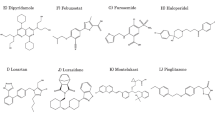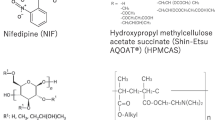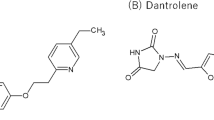Abstract
Purpose. The aim of this study was to examine if sparging with CO2(g) could be used to establish stable biorelevant bicarbonate buffers, in aqueous medium, for use in dissolution characterization of low-solubility ionizable drugs.
Methods. Preparation of the bicarbonate-containing dissolution medium was monitored by use of a commercially available fiberoptic probe to measure the concentration of dissolved CO2(aq). Intrinsic dissolution measurements at 100 rpm, 37°C for indomethacin and dipyridamole were performed using a rotating disk and UV detection at pH 6.8 and 5.0 in a USP dissolution vessel apparatus.
Results. Indomethacin dissolution at pH 6.8 was significantly impacted by the concentration of CO2(g) in the sparging gas. Dipyridamole flux at pH 6.8 was independent of buffer species or buffer concentrations studied. However, dipyridamole dissolution at pH 5 was also a strong function of the concentration of CO2(g) in the sparging gas.
Conclusions. Stable bicarbonate biorelevant buffers could be established to perform intrinsic dissolution rate determinations for indomethacin and dipyridamole as long a continuous gas sparging of CO2(g) was used. Depending of the pH of the dissolution medium, the intrinsic dissolution rates of both indomethacin and dipyridamole were affected by the bicarbonate concentration. Sparging with CO2(g) to create physiologic buffers has a unique advantage over conventional buffers in that gas sparging serves as a continuous source of bicarbonate buffer species. This advantage was demonstrated by performing dissolution experiments at pH values typically associated with the fed state (pH 5) and applying relatively low CO2(g) pressures, resulting in bicarbonate concentrations less than 0.5 mM. It was demonstrated that CO2(g) sparging at a pH consistent with the fed state created an in-situ bicarbonate buffer at low concentrations, which had a significant impact on the dissolution of a basic drug such as dipyridamole.
Similar content being viewed by others
References
Guidance for Industry on Waiver of In Vivo Bioavailability and Bioequivalence Studies for Immediate Release Solid Oral Dosage Forms Based on a Biopharmaceutics Classification System. U.S. Department of Health and Human Services, Food and Drug Administration, Center for Drug Evaluation and Research, Washington, DC, 2000.
Biopharmaceutics Drug Classification and International Drug Regulation Seminar and Open Forum. May 17, 1995, Princeton, New Jersey, Proceedings Booklet, p. 12.
G. Flemström. Gastric and duodenal mucosal secretion of bicarbonate, In L. Johnson, editor-in-chief, Physiology of the Gastrointestinal Tract, 3rd ed., vol. 2, Raven Press, New York, 1994, pp. 1285-1309.
K. G. Mooney, M. A. Mintun, K. J. Himmelstein, and V. J. Stella. Dissolution kinetics of carboxylic acids II: effect of buffers. J. Pharm. Sci. 70:22-32 (1981).
J. G. Aunins, M. Z. Southard, R. A. Meyers, K. J. Himmelstein, and V. J. Stella. Dissolution of carboxylic acids III: effect of polyionizable buffers. J. Pharm. Sci. 74:1305-1316 (1985).
D. P. McNamara and G. L. Amidon. Reaction plane approach for estimating the effects of buffers on the dissolution rate of acidic drugs. J. Pharm. Sci. 77:511-517 (1988).
Z. Ramtoola and O. I. Corrigan. Influence of the buffering capacity of the medium on the dissolution of drug-excipient mixtures. Drug Dev. Ind. Pharm. 15:2359-2374 (1989).
J. N. Butler. Carbon Dioxide Equilibria and Their Applications, Lewis Publishers, Chelsea, Michigan, 1991.
M. Smeets-Peeters, T. Watson, M. Minekus, and R. Havenaar. A review of the physiology of the canine digestive tract related to the development of in vitro systems. Nutr. Res. Rev. 11:45-69 (1998).
M. Kristensen. Titration curves for gastric secretion. Scand. J. Gastroenterol. Suppl. 32:11-144 (1975).
W. D. W. Rees, D. Botham, and L. A. Turnberg. A demonstration of bicarbonate production by the normal human stomach in vivo. Dig. Dis. Sci. 27:961-966 (1982).
G. R. Bucher, J. C. Flynn, and C. S. Robinson. The action of the human small intestine in altering the composition of physiological saline. J. Biol. Chem. 155:305-313 (1944).
M. Repishti, D. L. Hogan, V. Pratha, L. Davydova, M. Donowitz, C. M. Tse, and J. I. Isenberg. Human duodenal mucosal brush border Na+/H+ exchangers NHE2 and NHE3 alter net bicarbonate movement. Am. J. Physiol. Gastrointest. Liver Physiol. 281:G159-G163 (2001).
S. J. Rune. Acid-base parameters of duodenal contents in man. Gastroenterology 62:533-539 (1972).
J. G. Hardman, L. E. Limbird, and A. Goodman Gilman, eds. Goodman & Gilman's The Pharmacological Basis of Therapeutics, 10th ed., McGraw-Hill, New York, 2001.
J. D. Hamilton, A. M. Dawson, and J. P. W. Webb. Observations upon small gut "mucosal" pO2 and pCO2 in anesthetized dogs. Gastroenterology 55:52-60 (1968).
G. O. Barbezat and M. I. Grossman. Intestinal secretion: stimulation by peptides. Science 174:422-424 (1971).
L. C. McGee and A. B. Hastings. The carbon dioxide tension and acid-base balance of jejunal secretions in man. J. Biol. Chem. 142:893-904 (1942).
S. Rune and F. Henriksen. Carbon dioxide tensions in the proximal part of the canine gastrointestinal tract. Gastroenterology 56:758-762 (1969).
H. W. Davenport. Physiology of the Digestive Tract, 5th ed., Year Book Medical Publishers, Chicago, 1984.
A. White, P. Handler, and E. L. Smith. Principles of Biochemistry, 4th ed., McGraw-Hill, New York, 1968.
J. B. West, ed. Best and Taylor's Physiological Basis of Medical Practice, 11th ed., Williams & Wilkins, Baltimore, 1985.
L. R. Johnson. Gastrointestinal Physiology, 6th ed., Mosby, St. Louis, 2001.
D. Taylor and G. Gutierrez. Gastrointestinal tonometry: basic principles and recent advances in monitoring regional CO2 metabolism. Semin. Respir. Crit. Care Med. 20:17-27 (1999).
The United States Pharmacopeia USP 24, The National Formulary NF 19, United States Pharmacopeial Convention, Inc., Rockville, Maryland, 1 January, 2000, p. 2236.
E. Galia, E. Nicolaides, D. Horter, R. Lobenberg, C. Reppas, and J. B. Dressman. Evaluation of various dissolution media for predicting in vivo performance of class I and II drugs. Pharm. Res. 15:698-705 (1998).
A. Bardow, D. Moe, B. Nyvad, and B. Nauntofte. The buffer capacity and buffer systems of human whole saliva measured without loss of CO2. Arch. Oral Biol. 45:1-12 (2000).
S. D. Mithani. Dissolution and precipitation of dipyridamole: effect of pH and bile salt concentration. Doctoral Thesis, University of Michigan, Ann Arbor (1998).
G. Mooney, M. A. Mintun, K. J. Himmelstein, and V. J. Stella. Dissolution kinetics of carboxylic acids I: effect of pH under unbuffered conditions. J. Pharm. Sci. 70:13-22 (1981).
E. S. Kostewicz, U. Brauns, R. Becker, and J. B. Dressman. Forecasting the oral absorption behavior of poorly soluble weak bases using solubility and dissolution studies in biorelevant media. Pharm. Res. 19:345-349 (2002).
R. M. Noyes, M. B. Rubin, and P. G. Bowers. Transport of carbon dioxide between gas phase and water under well-stirred conditions: rate constants and mass accommodation coefficients. J. Phys. Chem. B 100:4167-4172 (1996).
Author information
Authors and Affiliations
Corresponding author
Rights and permissions
About this article
Cite this article
McNamara, D.P., Whitney, K.M. & Goss, S.L. Use of a Physiologic Bicarbonate Buffer System for Dissolution Characterization of Ionizable Drugs. Pharm Res 20, 1641–1646 (2003). https://doi.org/10.1023/A:1026147620304
Issue Date:
DOI: https://doi.org/10.1023/A:1026147620304




